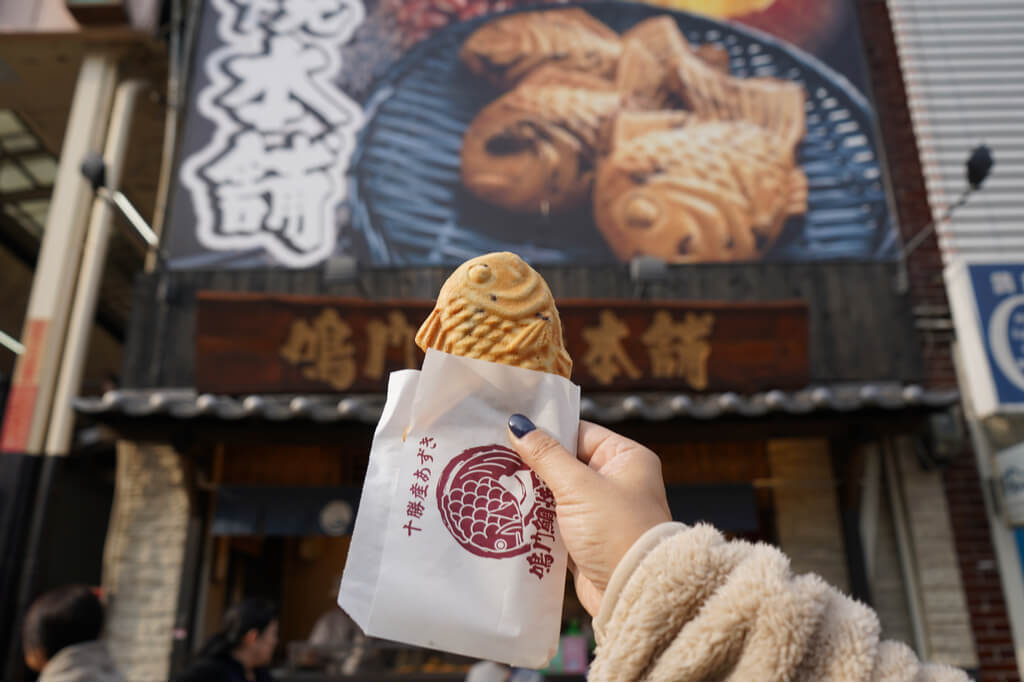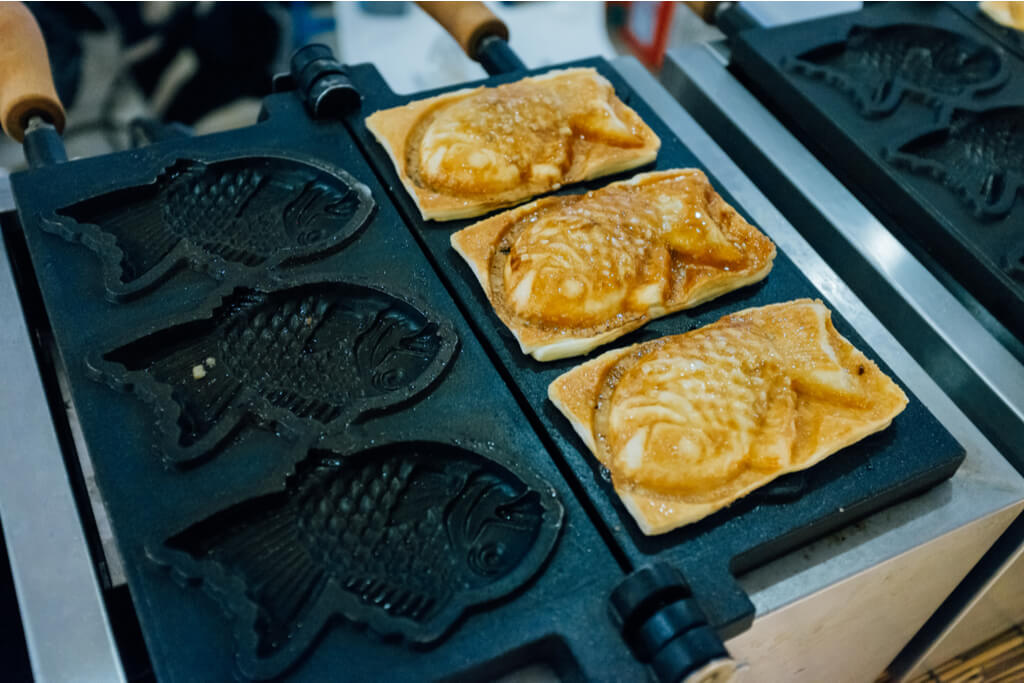If you like Japanese snacks, you’ve probably already seen these fish-shaped cakes. But how much do you know about them? Taiyaki, a famous Japanese pastry designed with the features of a cartoonish fish, is a traditional Japanese snack that has been enjoyed in Japan for over a century. Read on to learn all about taiyaki and why it is one of the top street foods in Japan and abroad!
Table of Contents
ToggleWhat is Taiyaki?
Given the eye-catching fish shape, you might be forgiven for assuming taiyaki is a savory seafood snack or unusual fish bread. As a matter of fact, taiyaki is a treat similar to pancakes or waffles, and usually sweet! With a slightly thinner batter than pancakes, this Japanese treat is thick and crispy around the edges and chewy towards the center, with a texture ideally suited for flavored fillings.
Traditionally, the filling consisted almost exclusively of mashed azuki beans (Japanese sweet red beans), similar to the Japanese red bean pancake, dorayaki. Nowadays, you’ll find all kinds of sweet varieties of this pastry. However, there are a few savory ones too!

The History of the Fish-Shaped Pastry
Compared to other wagashi (traditional Japanese sweets), taiyaki is a relatively modern addition to Japanese treats. Dating back to 1909, the recipe is an adaptation of an older Japanese sweet, imagawayaki, a thick pancake with a sweet red bean filling.
During the An’ei years (1772-1781) of the Edo period, confectioners invented and popularized imagawayaki, but by the early 1900s, imagawayaki salesmen were actively seeking new ways to revitalize their industry. One idea involved making their imagawayaki pancakes into various animal shapes, such as turtles and rabbits, to attract more customers.
Looking for a taste of Japanese culture, especially treats like taiyaki? Sakuraco is a subscription box delivering delicious traditional snacks and teas straight from Japan to your door, every month!
The attempts to re-popularize imagawayaki were largely unsuccessful until 1909 when one imagawayaki seller decided to shape his pancakes like red seabream, or “tai” in Japanese. Sea bream is significant in Japanese cuisine, especially on special occasions such as New Year’s Day and weddings. One reason for this was the higher cost of fish, which is still quite expensive in Japan today.
Another reason is the sea bream’s long-standing association with good luck and celebration. The word tai rhymes with the Japanese word medetai, meaning joyful, and a Japanese expression further associates the two: tai wa medetai, or “sea bream is for celebrations.” Unlike the rabbit and turtle imagawayaki, pancakes shaped like red seabream took off immediately. Before long, it had become a new kind of snack, dubbed taiyaki: fried sea bream.
Since then, taiyaki has become a cornerstone of Japanese street food culture. While permanent, brick-and-mortar taiyaki shops can be found all around Japan. It is common to find food stands selling this snack near shrines and sightseeing destinations and frequently encountered at local festivals. In this way, Japan’s little fish pastry stays true to its celebratory origins: primarily consumed on the go as a festival food or during special occasions.
Types of Taiyaki
One area in which modern taiyaki departs from its traditional counterpart is fillings. While it traditionally has red bean filling, these days, you’ll find that’s only one of many options you can choose from! Some of the best taiyaki flavors include custard, chocolate, and matcha. Although slightly rarer, you can also find a sakura-flavored version in springtime, sweet potato taiyaki, and tasty combo varieties, including some other popular foods to try in Japan, such as cheese, gyoza, and even okonomiyaki!

Last but not least, just like pancakes or waffles, taiyaki can be combined with ice cream to significant effect! Like ice cream melonpan (melon bread), in this variety, the taiyaki serves as a cone for soft-serve Japanese ice cream, essentially replacing or combining it with other taiyaki fillings. The taiyaki, a famous fish-shaped pastry, transforms into an ice cream cone in a delightful twist. Known as ice cream melonpan, it replaces or combines traditional fillings with soft-serve Japanese ice cream. The taiyaki’s crunchy exterior complements the creamy ice cream, creating a delightful contrast. This unique treat is especially beloved during Japan’s hot summer months.
Can I make taiyaki?
Absolutely! Taiyaki tastes best while still hot from the pan as you wander around a park during a matsuri (Japanese festival). If getting one fresh from a street vendor isn’t an option, you can also find premade frozen ones in Japanese supermarkets or—even better—make your own!
Making taiyaki is easy, save for a tiny caveat. To make the traditional fish-shaped variety of this snack at home, you’ll need a taiyaki pan. It’s a sandwich press with fish-shaped molds, similar to a waffle maker. While purchasing a dedicated taiyaki pan might appear troublesome, it is gratifying. The pan is essential for spacious fillings and a crispy edge on fish-shaped pastries. It’s easily accessible and reasonably priced online, making it a must-have for dedicated enthusiasts.

Luckily, the only other things you’ll need for taiyaki are basic home staples: cake flour, baking powder and soda, milk, sugar, eggs, and whatever ingredients you want for your filling. To begin with, you’ll need to make the batter. You’ll want to prepare the wet and dry ingredients separately before combining them, like a pancake or waffle batter.
How do I make taiyaki?
First, sift the cake flour, baking powder, and baking soda into a bowl with the sugar. Whisk the egg and milk in a separate bowl before combining with the dry ingredients and whisking well. At this point, most taiyaki recipes suggest refrigerating the mix for up to an hour. This ensures a smooth batter. If you’re short on time and want to skip this step, lightly whisk the wet and dry ingredients. This creates less gluten.
Once the batter is ready, it’s time to make the taiyaki! Heat the pan and brush it with vegetable oil. When the pan is hot, pour batter into the molds on one side until about half full, top with your filling of choice, then cover with more batter. Close the taiyaki pan and cook for about 5 minutes, flipping occasionally to ensure both sides are cooked equally. Once golden brown, carefully remove the taiyaki from the pan and let it cool, or eat it immediately for that authentic, mouth-burning street food experience!
For anyone interested in Japanese food and culture, taiyaki is an unmissable experience. Indeed, this treat is so prevalent in Japan that it’s become part of Japanese pop psychology, with how you eat taiyaki said to reveal an essential aspect of your personality.
People who eat their taiyaki starting with the head are said to be optimistic and assertive. Tail-eaters, conversely, are believed to be calm and idealistic. Finally, those who bite into this snack from the side are energetic, athletic, and easy-going. If you’ve had it before, which category do you fall into? If you haven’t, where do you think you’ll end up? Let us know in the comments below!










